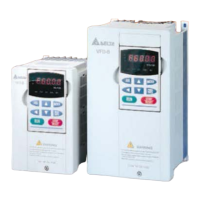How to troubleshoot OFF POWER LED on Delta VFD4A2MS43ANSAA DC Drives?
- LLisa RyanAug 10, 2025
If the POWER LED is off, it indicates no power. Check if the connection between the CMM-PD02 and the AC motor drive is normal.

How to troubleshoot OFF POWER LED on Delta VFD4A2MS43ANSAA DC Drives?
If the POWER LED is off, it indicates no power. Check if the connection between the CMM-PD02 and the AC motor drive is normal.
What to do if the Delta VFD4A2MS43ANSAA DC Drives NET LED flashes orange?
If the NET LED flashes orange, it means that the CMM-PD02 fails to communicate with the AC motor drive. To solve this, switch off the power and check whether the CMM- PD02 is correctly installed and normally connected to the AC motor drive.
Why is the NET LED on my Delta VFD4A2MS43ANSAA red?
A red light on the NET LED indicates that the CMM-PD02 is not connected to the PROFIBUS DP bus. To resolve this, connect the CMM-PD02 to the PROFIBUS DP bus.
What to do if the Delta DC Drives NET LED flashes red?
If the NET LED flashes red, it signifies an invalid PROFIBUS communication address. To fix this, set the PROFIBUS address of the CMM-PD02 between 1–125 (decimal).
Specifies minimum mounting clearances (A, B, C) in mm for different installation methods and ambient temperatures.
Details airflow rates and power dissipation for various AC motor drive models across different frames.
Illustrates the system wiring diagram, including power input, NFB or fuse, electromagnetic contactor, and AC reactors.
Provides detailed wiring instructions for input and output terminals, control terminals, and optional accessories.
Presents the main circuit diagram with terminals for input power, output terminals, DC reactor, and brake resistor.
Details specifications for main circuit terminals, including ring lug dimensions and wire gauge requirements.
Describes the KPMS-LE01 Keyboard Panel, including displayed items and descriptions of keypad functions.
Details the operation process for the keypad, including main page selection, setting parameters, and shifting data.
Summarizes drive parameters, including AC Motor Drive Identity Code and Rated Current Display.
Details basic motor parameters such as maximum/rated frequency, voltage, and mid-point settings for motors 1-4.
Explains digital input and output parameters, including two-wire/three-wire operation control and multi-function input/output commands.
Details analog input/output parameters, including AVI/ACI selection, bias, gain, filter time, and AFM output settings.
Covers motor parameters such as auto-tuning, full-load current, rated power, speed, number of poles, and stator/rotor resistance.
Details protection parameters including low voltage level, over-voltage stall prevention, and over-current stall prevention.
Explains special parameters like software brake chopper, DC brake settings, and restart after power loss.
Details high-function PID parameters, including terminal selection, proportional/integral/differential gains, and output limits.
Covers communication parameters for COM1, including address, transmission speed, fault treatment, and protocol.
Details parameters for speed feedback control, including MI7 pulse input, electrical gear, and FOC/TQC settings.
Explains advanced parameters such as system control, inertia, ASR/ASR2 switch frequency, and torque limits.
Details protection parameters for output frequency, DC bus voltage, output current, and IGBT temperature at malfunction.
Details the wiring requirements for CANopen communication, including RJ45 cable usage and terminating resistors.
Details CANopen fault codes, including display, fault name, description, and related corrective actions.
Lists important notes before using a PLC, covering communication ports, PLC preset node, and host controller access.
Explains basic principles of PLC ladder diagrams, including program scanning and introduction to ladder diagrams.
Provides a table of PLC error codes and their recommended error resolution for various abnormalities.
Provides a basic function description of the MS300 series' Safe Torque Off (STO) function and its international standards.
Describes the STO related terminal functions, including +24V, S1, S2, and DCM terminals and their descriptions.
Shows the circuit diagram for the safe control loop and wiring diagrams for STO mode.
Provides error code descriptions and troubleshooting instructions for STO/STL faults, including causes and corrective actions.












